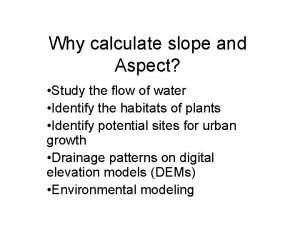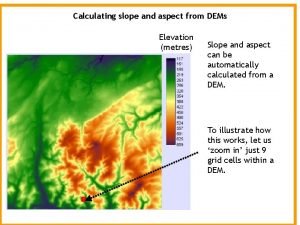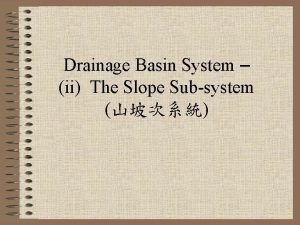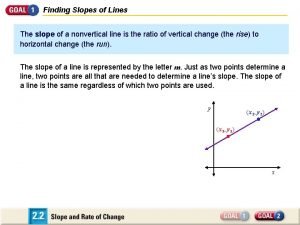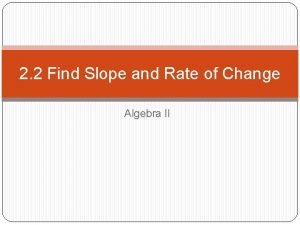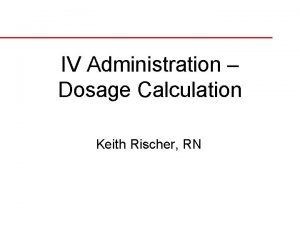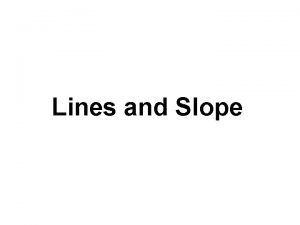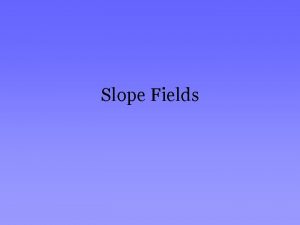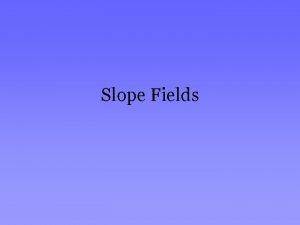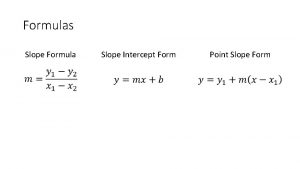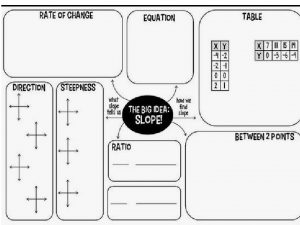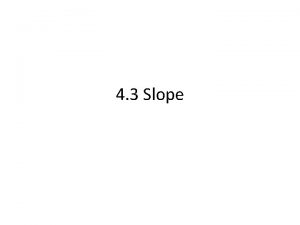Why calculate slope and Aspect Study the flow













- Slides: 13

Why calculate slope and Aspect? • Study the flow of water • Identify the habitats of plants • Identify potential sites for urban growth • Drainage patterns on digital elevation models (DEMs) • Environmental modeling

Slope • Slope measures the steepness of the surface at any particular location. • Slope is often measured in degrees or in percent rise

Aspect • Aspect measures the direction of steepest slope for a location on the surface. • It is usually measured in degrees, where 0 degrees is due north, 90 degrees is due east, 180 degrees is due south, and 270 degrees is due west.

Raster based GIS grid model • Using the elevations of the surrounding eight points in a 3 x 3 neighborhood. • To calculate the slope and aspect for cell “F” needs elevations at point A, B, C, G, K, J, I, E A B C D E F G H I J K L M N O P

A E I M B F C G D H J N K O L P 1. Calculate east-west gradient: ∆X = ((ZC + 2*ZG +ZK) – ZA+2*ZE+ZI))/8*cell size 2. Calculate north-south gradient: ∆Y = ((ZA + 2*ZB +ZC) – ZI+2*ZJ+ZK))/8*cell size

Slope & Aspect tan(Slope(F)) = squrt((∆x)2+ (∆Y)2) tan(Aspect(F)) = ∆x / ∆Y

Aspect A(80) B(74) C(63) D(89) E(69) F(67) G(56) H(78) I(60) J(52) K(48) L(60) M(59) N(49) O(47) P(40) Aspects indicate the steepest downslope direction Aspects are measured clockwise

Hydrologic Slope - Direction of Steepest Decent • Assign a flow direction to each grid cell based on the neighboring cell with the lowest elevation.

Flow Directions Eight Direction Pour Point Model Elevation Grid 32 64 16 120 103 164 132 102 110 8 128 1 4 2 Flow Direction Grid 110 107 2 4 8 1 4 16

Flow Accumulation 120 103 164 132 102 110 100 107 • Flow accumulation is calculated from flow directions. • It calculates the number of grid cells drain into an individual grid cell.

Flow Accumulation 120 103 16 0 0 0 132 102 110 0 3 0 110 107 0 • The flow accumulation grid has a value for each cell that represents the number of cells upstream from that cell. • Cells with higher values will be located in drainage channels rather than hillsides or ridges.

Watershed Delineation • Watersheds are delineated from the flow direction layer. It is the area flowing into a given outlet or pour point.

Stream network delineation • Flow accumulation threshold value defines the minimum or number of cells drainage area upstream necessary to define a stream. Cell size = 100 x 100 m Each cell represents 10, 000 m 2 in area. If delineate the streams for a 10, 000 cell flow accumulation threshold, the minimum drainage area upstream will be: 10, 000 x 10, 000 = 100, 000 m 2 or 100 km 2
 La structure du texte descriptif
La structure du texte descriptif How to measure aspect
How to measure aspect Slope aspect definition
Slope aspect definition Hey bye bye
Hey bye bye What is slope decline
What is slope decline Converting point slope to slope intercept
Converting point slope to slope intercept Slopes of lines
Slopes of lines Slope review classifying slope
Slope review classifying slope Mistakes in surveying
Mistakes in surveying Don't ask why why why
Don't ask why why why How to calculate cash flow from profit and loss statement
How to calculate cash flow from profit and loss statement How to calculate gtts/min
How to calculate gtts/min Drops per hour formula
Drops per hour formula Calculating iv drip rates
Calculating iv drip rates

